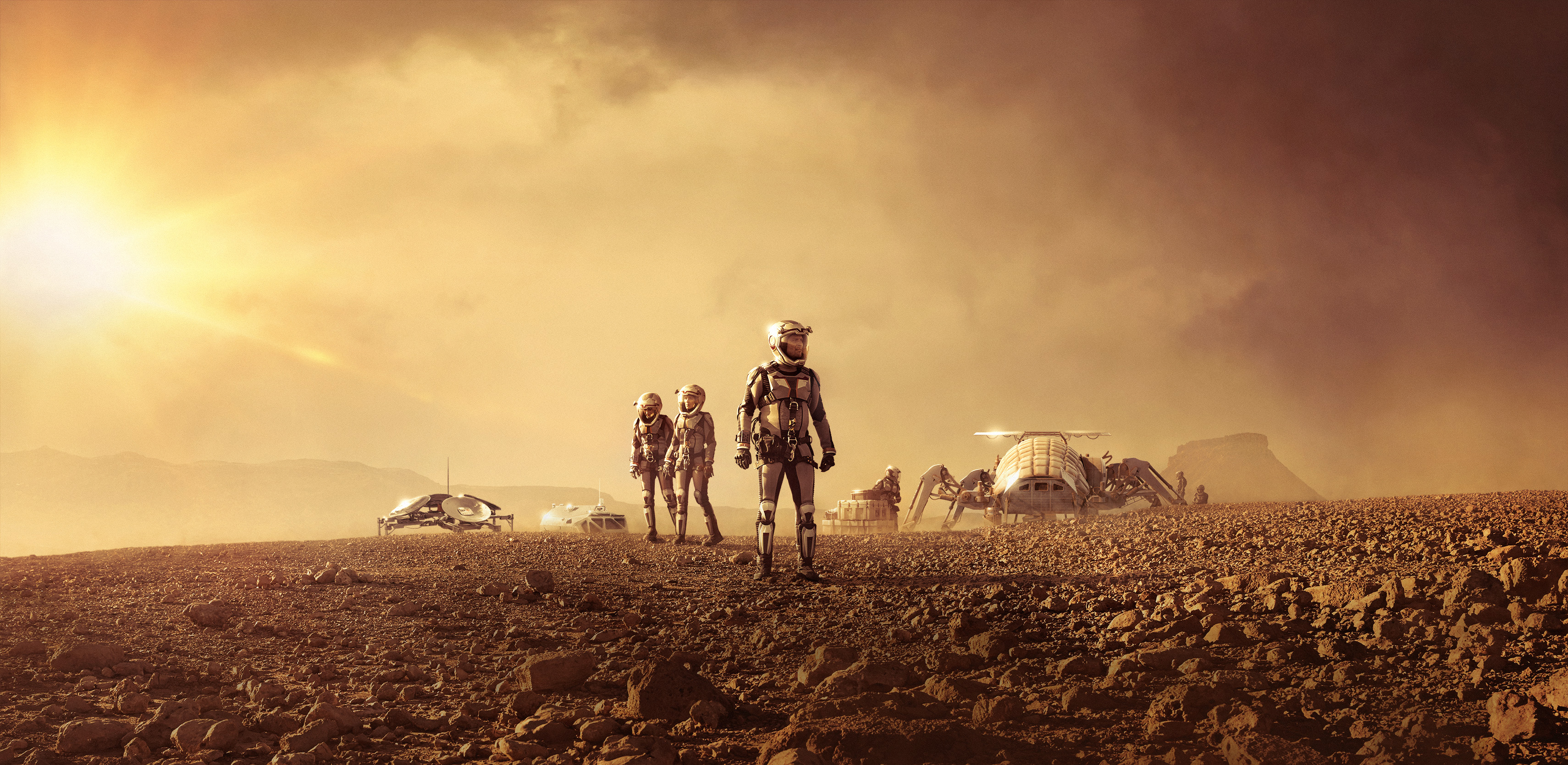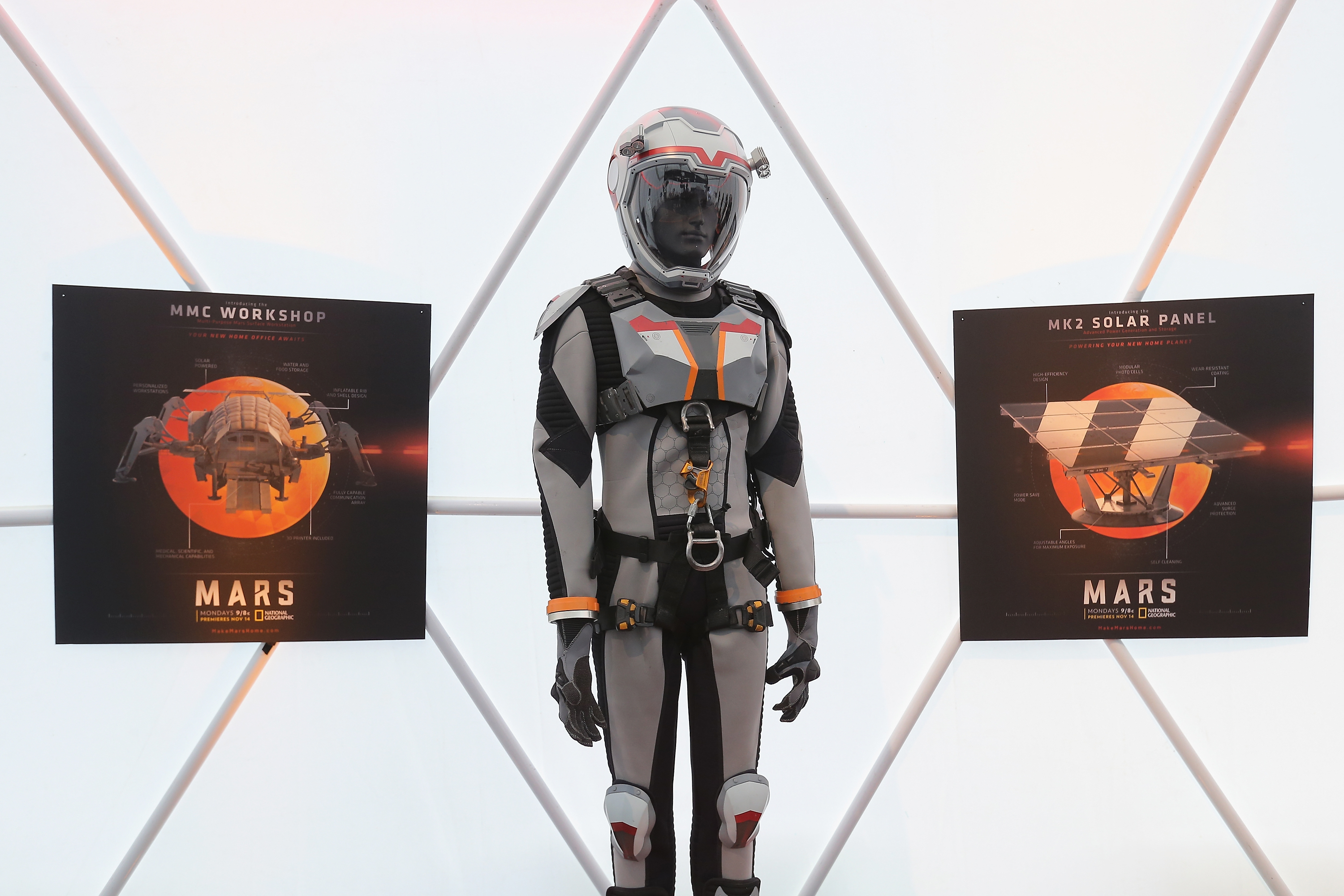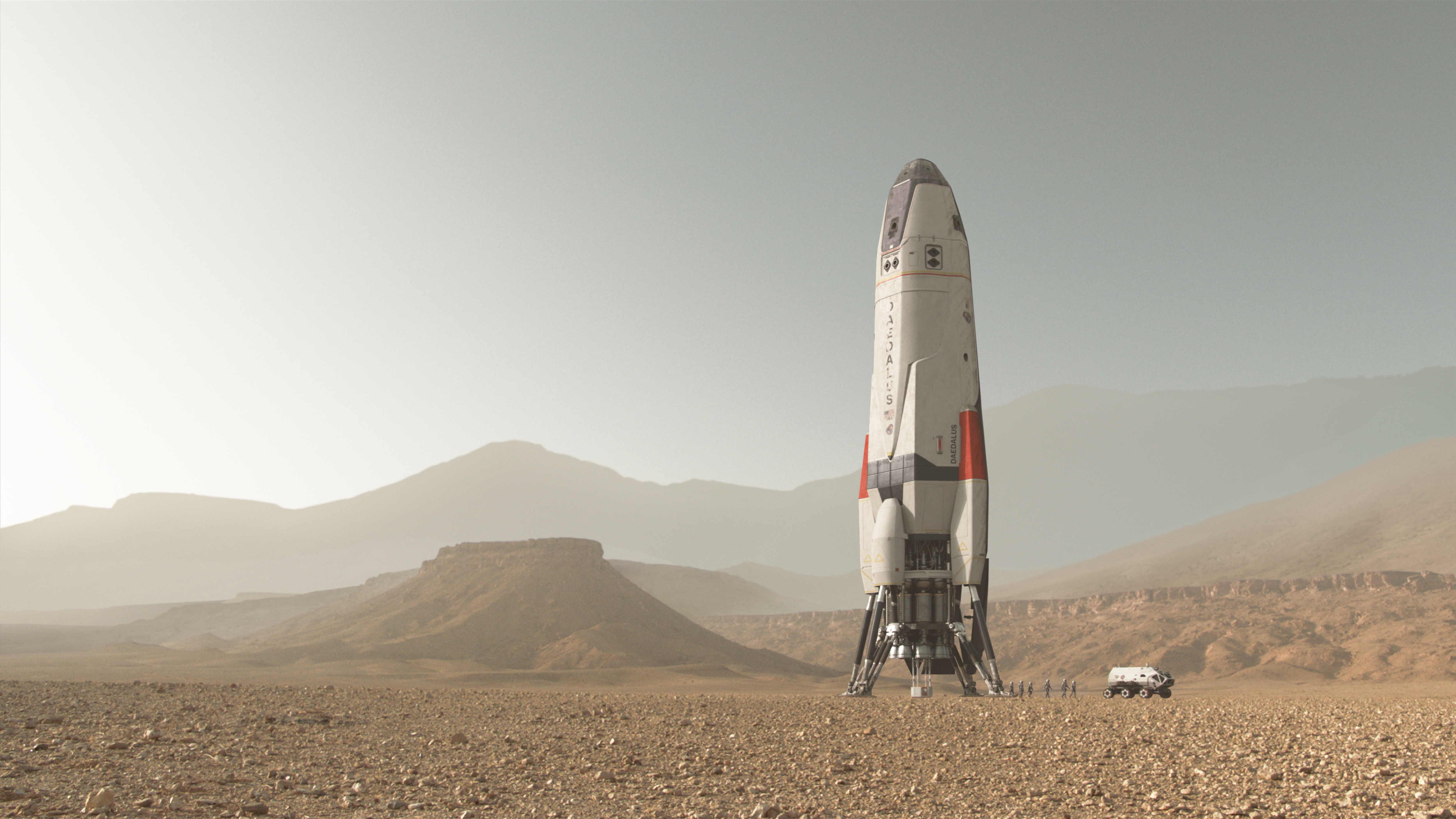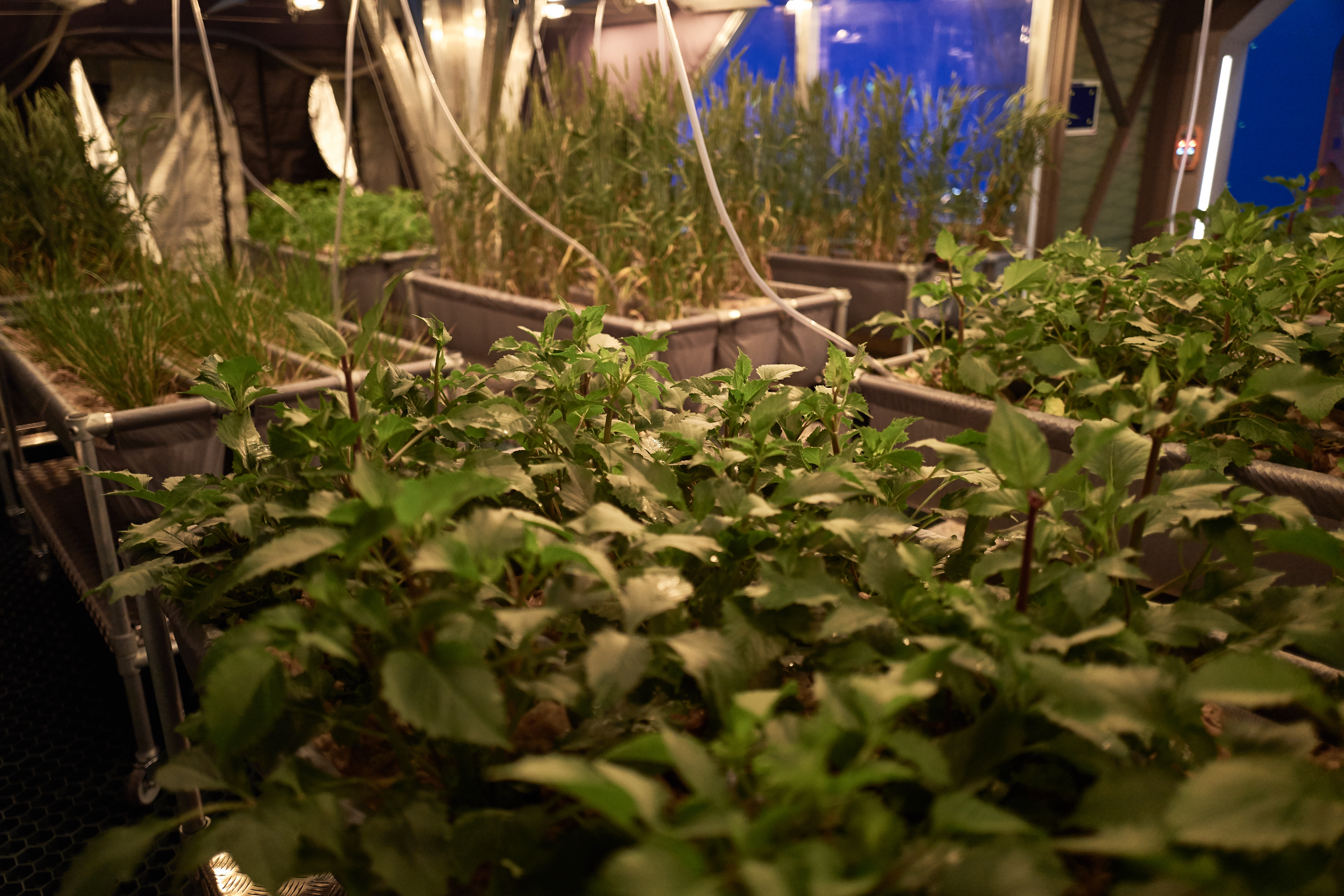Nat Geo's 'Mars' Miniseries Ready for Scientifically Accurate Liftoff

Watch humanity's first voyage to Mars unfold in National Geographic's new miniseries "Mars." The show premieres Monday (Nov. 14) at 8 p.m. EST in the U.S.
The global event series premieres internationally one day sooner, on Nov. 13. But there's no need to wait for the televised premiere regardless of where you are — National Geographic has already released the first episode online.
"Mars" portrays the story of the first crewed mission to the Red Planet with a unique storytelling format. Scripted scenes that take place in the year 2033 depict the journey to Mars, but these scenes are spliced with present-day interviews with real scientific experts. The show not only tells the story of the first mission to Mars, but it also provides plenty of present-day and historic context. ['Mars': The Epic National Geographic Channel Miniseries in Pictures]
People on Earth have long dreamed of setting foot on Mars. As National Geographic's new series shows, it will be no easy task. Getting there is but one of the many struggles the first Mars colonists will face. Surviving and thriving on the Red Planet will likely be a greater struggle, the show suggests.
To depict the first human journey to Mars as accurately as possible, the show had information from space science experts for everything from rocket science to spacesuit and set designs. The makers of "Mars" were impressively thorough in their attempts to make the show scientifically accurate by summoning a great deal of input from a wide variety of specialists.
"What is really amazing is that people at Radical Media who produced this, and [executive producer] Ron Howard and the people at National Geographic — the one thing they were all on board about was getting this right," Stephen Petranek, author of the book "How We'll Live on Mars," told Space.com.
"Unlike [the movie] "The Martian," which had a lot of areas where you could rip into the accuracy of science behind what you're seeing in the drama, I feel very comfortable that this is as close to perfectly accurate as you're ever going to get in trying to forecast exactly what would happen in sending the first people to Mars and starting the first civilization there," Petranek added.
Get the Space.com Newsletter
Breaking space news, the latest updates on rocket launches, skywatching events and more!
Experts weigh in
Of the many experts who were interviewed in "Mars," no one had quite as much impact on the series as SpaceX's Elon Musk. The private spaceflight company recently unveiled its concept for the Interplanetary Transport System that could one day carry the first colonists to Mars.
At the world premiere of "Mars" in New York City on Oct. 26, producer Justin Wilkes of RadicalMedia said that his team were granted unprecedented access to Elon Musk and the whole SpaceX team, whom he called "some of the greatest minds that are dreaming up and actually engineering this mission."

Other guests who appear on the show include NASA administrator Charles Bolden, astronaut James Lovell of the Apollo 13 mission, astrophysicist and TV star Neil deGrasse Tyson and "The Martian" author Andy Weir.
Several NASA scientists are interviewed in "Mars," but space scientists are far from the only kind of experts present in the show. Psychologist David Dinges of the University of Pennsylvania discusses the effects a journey to Mars would have on the human psyche. Casey Dreier, the director of space policy for the Planetary Society, and Thomas Kalil, deputy director at the White House Office of Science and Technology, discuss the policy implications of sending colonists to unclaimed territories.
Producing 'Mars'
Making "Mars" as realistic as possible required a tremendous amount of scientific information. The on-camera interviews merely scratch the surface of what the scientific community contributed to the making of the series. Even the scripted scenes, which required some creativity to conceptualize, were based almost entirely on advice from many different professionals.

The futuristic spacesuits the astronauts wear in "Mars" were created by the Italian costume designer Daniela Ciancio, and they were designed with real science in mind. Ciancio told Space.com that she based her design on actual spacesuit concepts by NASA and SpaceX. But her main inspiration was the BioSuit concept developed at the Massachusetts Institute of Technology. Mars spacesuits will need to be strong, flexible, lightweight and comfortable, Ciancio said.
Bobby Braun, a professor of space technology at Georgia Tech, provided technical aid to help keep the show accurate and realistic. In an interview with Space.com, Braun said that he conceptualized the Daedalus spacecraft in "Mars" by combining ideas from papers written by NASA, SpaceX, Lockheed Martin and academic researchers at universities.

One idea that Braun incorporated into the Daedalus is the use of supersonic retropropulsion to land on Mars. This technology is necessary for a large spacecraft to slow down in Mars' thin atmosphere before landing. SpaceX has already demonstrated this technology by landing its reusable rockets on Earth, but doing the same thing on Mars will be a lot different, Braun said.
Collaboration between the show's creative team and its science experts was crucial for keeping the show accurate, Wilkes said in an interview with Space.com. But the two groups never quarreled over science versus theatrics. Instead, Wilkes said that the scientists' input inspired the writers to come up with even more dramatic storylines without sacrificing science.
"It's more dramatic because it's based on science," Wilkes said.
How to act like an astronaut
Former NASA astronaut Mae Jemison, the first female African-American to go to space, gave the cast a crash course in how to walk, talk and behave like an astronaut. At the "Mars" world premiere, Jemison explained how she also helped the show's scriptwriters create dialogues that accurately portray the astronauts' emotions and interactions with each other.
"Mae really clarified from her own personal experience of going to space how much you have to contain your emotions and how important that is for all the crew around you," said Jihae, the South Korean singer who plays two roles on the series. In addition to being one of the Daedalus crew, she doubles as her own twin, who works in the mission control center on Earth.
One of the fun parts of astronaut training involved hopping in a swimming pool, actor Ben Cotton (Commander Ben Sawyer) said in an interview with Space.com. In the water, the actors learned the motions of walking in a spacesuit on Mars, Cotton said.
"Mars" was filmed in a desert in Kazakhstan, and Cotton said that suffering from the heat in his spacesuit actually helped him get into character. Though Mars is actually extremely cold, the heat gave the actors the exhausted appearance that they would have during a long hike on Mars.
Arrive, then thrive
When the Daedalus crew arrives on Mars, dome-shaped habitats have already been deployed. But there's one big problem: They land off-course and have to figure out a way to get to their new home, and it's a long, bumpy road ahead.
Getting to Mars is only the beginning. After arriving on the Red Planet, a whole new journey begins for the Mars colonists. Food, fuel and other supplies will be limited. While no life is known to exist on Mars, the colonists must find a way to sustain themselves by farming in enclosed habitats. They'll also need to figure out a way to mine water on Mars.

But these technologies, much like the rocket-propulsion technologies borrowed from SpaceX, are not far out of reach. In fact, much of the equipment required to survive on Mars already exists today. Astronauts at the International Space Station have grown plants in space, and the orbiting laboratory contains a water-recycling system to conserve and reuse water.
"I think the public will be surprised when they see how much of the prep work [to get to Mars] is actually happening already," Braun said. "I don't think people have connected the dots that when SpaceX goes from the Falcon to the Falcon Heavy that it means something about how we will settle Mars…I think one of the nice things about this series is that it mixes in some of the present day events, and so it's going to show not only what this future mission might look like and the drama of that future mission, but it's going to show all the stuff that's happening in 2016 to get us ready to go do those things."

Email Hanneke Weitering at hweitering@space.com or follow her @hannekescience. Follow us @Spacedotcom, Facebook and Google+. Original article on Space.com.
Join our Space Forums to keep talking space on the latest missions, night sky and more! And if you have a news tip, correction or comment, let us know at: community@space.com.

Hanneke Weitering is a multimedia journalist in the Pacific Northwest reporting on the future of aviation at FutureFlight.aero and Aviation International News and was previously the Editor for Spaceflight and Astronomy news here at Space.com. As an editor with over 10 years of experience in science journalism she has previously written for Scholastic Classroom Magazines, MedPage Today and The Joint Institute for Computational Sciences at Oak Ridge National Laboratory. After studying physics at the University of Tennessee in her hometown of Knoxville, she earned her graduate degree in Science, Health and Environmental Reporting (SHERP) from New York University. Hanneke joined the Space.com team in 2016 as a staff writer and producer, covering topics including spaceflight and astronomy. She currently lives in Seattle, home of the Space Needle, with her cat and two snakes. In her spare time, Hanneke enjoys exploring the Rocky Mountains, basking in nature and looking for dark skies to gaze at the cosmos.









